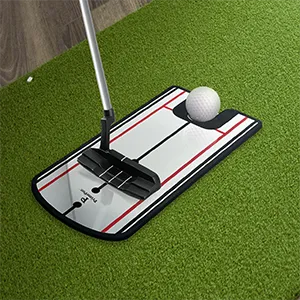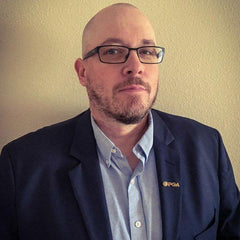Visit a tour player's practice area and you'll notice the same training tool scattered everywhere: putting mirrors. Flat reflective surfaces with alignment lines. Nothing complicated. Yet this basic piece of equipment has fixed more putting strokes than nearly any gadget you can buy. Inconsistent putting? Can't figure out why? A mirror might solve it.
Why Putting Mirrors Work
Most golfers have no clue where their eyes are positioned at address. The same goes for putter face angle. You assume everything's square, but you're really just guessing. Mirrors give you something guessing can't: feedback.
What you see in a putting mirror is reality. Eye position, shoulder alignment, face angle — all of it reflected back while you're standing over the ball. You can lie to yourself about your putting setup until you actually look at it. Tour pros rely on mirrors because they expose the difference between perception and reality. Close that gap and you'll putt better tomorrow.
Setting Up Your Putting Mirror Correctly
Put the mirror on flat ground. It could be a practice green or a putting mat in your garage. The center line needs to aim at your target. Most models have a ball marker or a small hole in the middle for ball placement.
Set up as you normally would — place the ball on the marker. Alignment lines should run parallel to your putter face and perpendicular to your target. Take your time getting this right. If the mirror sits crooked, you're practicing the wrong thing.
Checking Your Eye Position
Eye position is huge, though golfers don't treat it that way. Ideally, your eyes are directly over the ball or barely inside the target line. Get too far inside and you'll yank putts left. Too far outside means pushes to the right.
Look down at the mirror from your stance. Both eyes should appear in the reflection, centered over the line or marker. Seeing mostly forehead? Eyes off to one side? Adjust your posture until the reflection looks right.
Check this over and over. Hit five putts, six putts, verifying eye position each time. Your body memorizes positions through repetition, not intention.
Squaring Your Putter Face
The face angle at impact determines where the ball starts. Miss by a few degrees and you'll blow makeable putts. The mirror's lines show you instantly whether your face is square.
Get into your stance and check where the putter sits in relation to the mirror's lines. The bottom edge should run perfectly parallel. If it doesn't, your face is open or closed before you even take the club back.
Adjust until everything lines up. Hit putts. Check the face every single time. Muscle memory builds through volume, not through thinking about it during your Saturday round.
Aligning Your Shoulders
Your shoulders play a significant role in determining the path of your stroke. Aim them left and you'll cut across the ball outside-in. Aim right and you're swinging too far from inside. Both patterns wreck your ability to hole putts.
Mirrors usually have lines for checking shoulder alignment. Stand over it and look at your reflection. Your shoulders should run parallel to those alignment marks. One shoulder higher or more forward? Fix it until they're level and square.
This is harder to see than you'd expect. Film yourself from down the line if the mirror isn't clicking. Once you understand what square shoulders actually look like, the mirror becomes an easy verification tool.
Practicing Your Path
Some people use mirrors for path work. Trickier than the other drills. You make practice strokes and watch the putter head track along the center line in the reflection. Back and through, staying on line.
Works well for short putts where the stroke is relatively straight. Longer putts are different. The putter naturally moves inside on both sides of the ball. Forcing a straight-back, straight-through path on a 20-footer will make your stroke robotic and weird.
Better to focus on setup with the mirror. Path problems tend to disappear once your eyes, shoulders, and face angle are dialed in.
Building Effective Mirror Practice Sessions
Don't just whack balls while occasionally glancing down. Structure matters. First 10 minutes? Setup only. No putts. Just checking eyes, face angle, shoulders. Get familiar with what correct actually looks like.
Then hit putts in groups of five. Before each one, verify a different fundamental. Putt one: eyes. Putt two: face angle. Putt three: shoulders. Cycle through. Keeps your attention sharp instead of drifting after you've hit a dozen balls.
End every practice session with 10 putts without the mirror. You're teaching yourself to recreate a proper setup from feel alone. If those last 10 roll on line consistently, the mirror's doing its job.
Common Mirror Training Mistakes
Biggest mistake? Using a mirror twice and expecting your stroke to stay fixed forever. Your body reverts to old habits fast. You need consistent mirror work to make new patterns stick, especially in the beginning.
Another problem is chasing perfection. Small setup variations are normal. They don't destroy your putting. Eye position close? Shoulders mostly square? That's plenty good. Obsessing over perfect alignment just creates tension and kills your natural stroke.
Don't train exclusively with a mirror either. You also need regular putting practice focused on speed control, green reading, and actually holing putts. Mirrors build good fundamentals, but fundamentals alone don't win matches.
When to Use Your Mirror
Use it constantly when learning proper setup or changing something technical. Daily work for two or three weeks gets new positions locked in. After that, maintenance mode: two or three sessions per week.
Pull it back out when putting feels off. Setup flaws creep in slowly, usually without you noticing. A quick mirror check shows what's drifted so you can correct it before the problem becomes permanent.
Five minutes with a mirror before a big round can help, too. Reminds your body what correct positions feel like and gives you confidence that your fundamentals are solid.
Choosing the Right Mirror
Most mirrors get the job done. Look for clear alignment lines and a surface that won't scratch if you drop it. Size doesn't matter as much as you'd think, though bigger mirrors make it easier to see everything at once.
Some have extra features. Gate attachments. Adjustable lines. Sometimes useful, never essential. A basic mirror with a center line and ball marker covers everything you actually need.
Prices run from $15 to over $100. Expensive doesn't mean better for learning. Start cheap. Upgrade later if you want the extras.
A putting mirror won't turn you into a great putter by itself. But it will show you whether your fundamentals help or hurt your stroke. Fix what the mirror reveals and your ball will roll more consistently. More consistency means lower scores and fewer three-putts. For what they cost and how simple they are, almost nothing works better.





